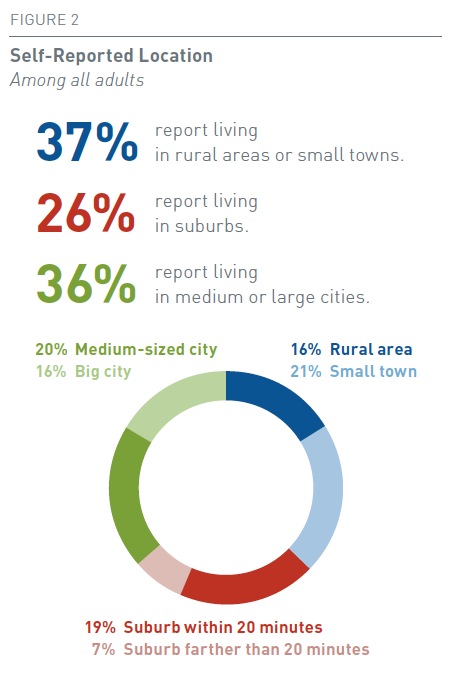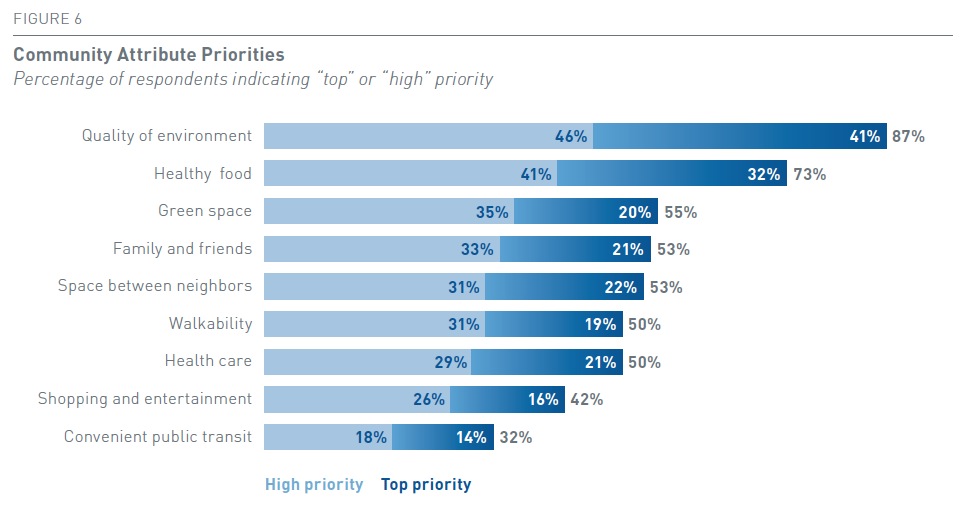URBAN LAND INSTITUTE
Executive Summary
In 2013, ULI published a national survey of Americans’ preferences and priorities regarding their communities, housing, and transportation. America in 2013 found that Americans were mostly satisfied with the quality of life in their communities and uncovered a strong desire for compact and mixed-use communities. America in 2015 expands upon the 2013 survey approach with new questions exploring priorities for and barriers around healthy communities and lifestyles.
 How We Feel
How We Feel
Satisfaction with Communities and Housing
Americans overall express high levels of satisfaction with their communities and the homes in which they live. These expressions of satisfaction are very high for all demographic groups, although they dip among certain groups such as those with lower incomes, millennials, and renters.
- Eighty-seven percent of Americans are somewhat or very satisfied with the quality of life in their community, 88 percent are satisfied with their current homes, and 81 percent are satisfied with the housing options in their communities.
- Renters are less satisfied with their homes and communities than owners, and a quarter of renters are dissatisfied with their housing options.
- Millennials are the least-satisfied age group: 15 percent are dissatisfied with their community’s quality of life and their current homes, and 21 percent are dissatisfied with their housing options.
What We Value
Community Attribute Priorities
Survey respondents were asked about their priorities when it comes to what they want from where they live. A healthy environment rises to the top of the priority list, with healthy air and water and access to fresh, healthy food leading the pack.
- When considering where to live, the vast majority of people (87 percent) say that the quality of the environment is a top or high priority.
- How walkable a neighborhood is—including sidewalks, pedestrian crosswalks, and so forth—is a top or high priority for half of the public.
- A third (32 percent) say that having public transit is a high or top priority, with more low-income people sharing this view.
Barriers to Healthy Living
Community Design and Health
Despite the high priority placed on healthy community elements, a significant number of Americans face community design–related barriers to living a healthy lifestyle. While most people say they can easily access fresh food, African Americans and Latinos report greater difficulty. A considerable share of the population also says their community lacks outdoor recreational spaces, and that traffic and crime make it unsafe to walk in their neighborhoods.
- Despite the fact that fresh, healthy food is a top or high priority for nearly three-quarters of Americans, 16 percent of the country—including 28 percent of African Americans and 25 percent of Latinos—say that healthy food is not available in their communities.
- A quarter of people say that traffic makes it unsafe to walk, and 21 percent say that crime in their neighborhoods makes it unsafe to walk.
- Thirty-eight percent of Americans say there is a lack of convenient outdoor spaces in which to run, walk, or exercise in their community.
Download full version (PDF): America in 2015
About the Urban Land Institute
www.uli.org
The Urban Land Institute provides leadership in the responsible use of land and in creating and sustaining thriving communities worldwide. ULI is an independent global nonprofit supported by members representing the entire spectrum of real estate development and land use disciplines.
Tags: Bicycling, Cycling, Pedestrian, ULI, Urban land Institute, Walking







 RSS Feed
RSS Feed